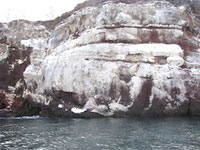

 | |||||||||||||||
|
|
Journals 2008/2009Tom Bogard
September 8, 2008 This morning's survey was focused on two islets that are known from previous surveys to have large populations of Galapagos Penguins. We got up at 4:30 in the moonless pitch black darkness that only can be found this far from any human settlement. We suited up and boarded the panga and departed a little after 5:00. The reason for the early departure was to catch the penguins before they went out to sea to feed at first light. Because of the darkness the panga driver had to be especially cautious, listening for the sound of the waves on the rocks as well as using his limited vision, to avoid underwater obstructions that could easily flip the boat. He had to balance the need to get close enough to see the birds and still be safe. To count the birds we had to use large flashlights to illuminate the shore. The penguins were standing on the rocks all looking out to sea waiting for just the right moment, that first ray of light from the rising sun, or for that first adventurous bird to venture into the water. It was an amusing sight. We circled both islands and counted what I thought was a large number of penguins. We made it back safely to the Queen Mabel and had breakfast. As the sun rose and the light got better I was able to get a good look at the two islets. At first they appeared to be made of some type of white rock. Upon further thought I realized that this could not be true, the volcanic rock of the islands was black or a similar very dark color. There were so many birds living on these small islets that their accumulated droppings had stained the rocks white. The law of averages has finally caught up with me. I have never been sick on any trip, including while staying in the rain forest of Costa Rica. That all changed today - fever, chills, diarrhea. The Queen Mabel is exacting her revenge for the disparaging remarks that I had made about her earlier. In between trips to the bathroom I spent most of the afternoon in my cabin. I must have looked pretty bad because Gustavo asked if I needed to go back on the supply boat that we would be meeting up with soon. He explained that if I did not go with the supply boat we would be 12 hours of hard sailing from the nearest medical facility. I declined his offer and acted as if I was feeling better. I was not the only one who was sick, but I did have the most severe symptoms. I suspect that the culprit was food poisoning. Nothing like being 4,000 miles from home in a small boat being tossed about in the ocean in the middle of nowhere! Looking back on it from the safety and comfort of my own home it was just all part of the adventure. Later in the afternoon we pulled into an area that had a remote outpost of the Galapagos National Park. The facility was put there in an effort to monitor the area and protect against poachers who fish illegally for sea cucumbers. The animals that are caught are then sent to Japan for consumption. We tied up next to the supply boat and took on supplies and fresh water. Pete, the photographer, and Andrea, the Aussie, talked me into going with them to shore. Pete wanted to climb up to a ridge top to take some pictures. I did not feel well but did not want to pass up an opportunity to explore. When we landed Pete took off and Andrea and I walked up the steep path at a much slower pace. It was more than worth the effort! We made it to a lower ridge that was actually the rim of volcanic crater. This was not a major vent and the crater was still over three quarters of a kilometer across! One "side" of the crater - almost half of it - appeared to have been blown out by an eruption and there was a lava plane that stretched for kilometers along the ocean from the rupture in the crater. The center of the crater was filled with water and had islands that were formed by lava domes. What an amazing site! I sat down in the dry vegetation and tried to permanently etch into my memory the scene before me. What a day! When I got back to the boat I was spent and went immediately to my cabin and crawled into my bunk. We depart for Fernandina.
|
||||||||||||||


